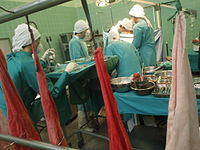
Photo from wikipedia
Purpose On November 24th 2017, the primary allocation unit was expanded from the donation service area (DSA) to a 250 mile radius from the donor. In the DSA based allocation… Click to show full abstract
Purpose On November 24th 2017, the primary allocation unit was expanded from the donation service area (DSA) to a 250 mile radius from the donor. In the DSA based allocation system, geographic disparities in donor lung availability (DLA) impacted waitlist outcomes. We sought to investigate if the new allocation system improved these disparities. Methods We conducted a retrospective cohort study of the 2 yr period before (Nov 2015-2017) and after the change (Nov 2017-2019). DLA was defined as the ratio of donor lungs in the primary allocation unit to the number of waitlist candidates. We divided transplant centers into quartiles of DLA and used multivariable competing risk models to examine the association between DLA and waitlist outcomes before and after the change. We used multivariable Cox proportional hazards to compare post-transplant survival. Results In the 2015-2017 cohort, there were 6720 patients with a median DLA of 160.5 (IQR: 79.8-383.0) compared to 7269 patients with median DLA of 143.3 (IQR: 115.0-198.5) from 2017- 2019. Relative to the highest quartile of DLA, the lowest quartile (indicating area with the fewest donors per waitlist candidate) had a 142% increased risk of death (HR: 2.42, CI: 1.66-3.55) in 2015-2017 compared to only a 39% increased risk of death (HR 1.39, CI: 1.09-1.78, p=0.007) in 2017-2019. When compared to the highest quartile of DLA, the lowest quartile of DLA had a 66% decreased risk of transplant (HR 0.34, CI: 0.31-0.38) in 2015-2017 and a 42% decreased risk of transplant (HR 0.58, CI: 0.54-0.63) in 2017-2019. There was no significant difference in post-transplant survival. The mean±SD LAS at transplant was 49.5± 19.1 and 43.7±14.9 in the highest and lowest quartiles from 2015-2017, compared with 50.0±19.2 and 47.3±17.6 from 2017-2019. Conclusion Although the expansion of the primary allocation unit improved geographic disparities in waitlist outcomes without a change in post-transplant survival, there still remain differences in waitlist mortality and transplant rate due to geography
Journal Title: Journal of Heart and Lung Transplantation
Year Published: 2021
Link to full text (if available)
Share on Social Media: Sign Up to like & get
recommendations!